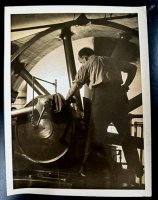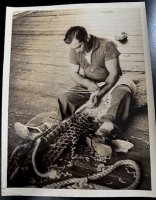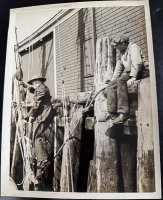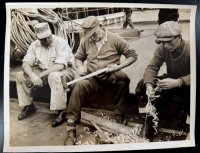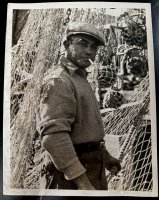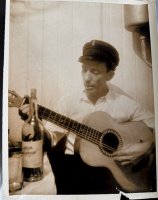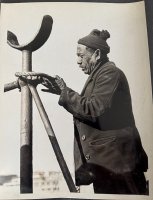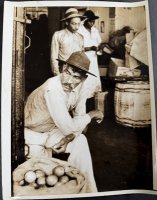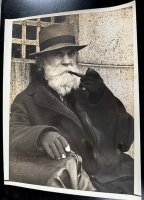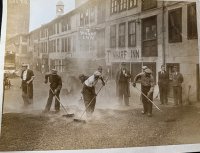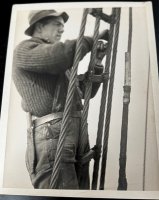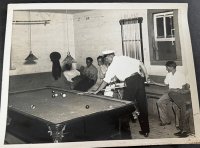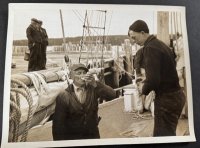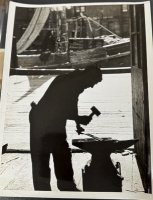MelroseBOOKS&ART
[MARITIME PHOTO ARCHIVE] Portfolio Original 1930s-40s Silver Prints BOSTON T WHARF Workers By Photojournalist ARTHUR HANSEN
$1650
Item Details
Boston, 1930s, Disbound
VG+
[MARITIME PHOTO ARCHIVE] Portfolio Original 1930s-40s Silver Prints BOSTON T WHARF Workers By Photojournalist ARTHUR HANSEN
Arthur Hansen, a renowned photojournalist was a photographer on staff of the Boston Herald from 1933 to 1952. He resided on T Wharf in Boston and published a collection of photographs in his book, "Photographic Memories of a T-Wharfer", a fictionalized version of life in a sloop in the Boston Harbor.
DESCRIPTION OF ITEM:
Discovered recently from the estate of Arthur Hansen, this photo archive collection is housed in contemporary binders - photos are behind glassine sleeved pages, laid-in not glued down.
The WHARF ARCHIVE includes fifty-four (54) 8" x 10" original gelatin prints. About 6 of them have a closed tear or clipped corner - the rest are in very good condition - no fading, etc.
ABOUT THE BOSTON T-WHARF WHERE THE PHOTOJOURNALIST RESIDES (From the Harvard Crimson 1961)
Situated near the foot, of State St., where it meets Atlantic Avenue, T Wharf was built sometime between 1708 and 1718 as a relatively unimportant appendage to adjacent Long Wharf, which, until 1868, extended all the way back to historic Faneuil Hall and docked the greatest schooners of its day along approximately one mile of pier. As steamships gradually superseded sailing vessels during the latter part of the 19th century, Boston's importance as a shipping port declined and the extraordinary length of Long Wharf became unnecessary. Needing additional land, the city constructed Atlantic Avenue, chopping Long Wharf in half and lopping off all but the right-hand "T" section of T Wharf.
In the 1880's, fishermen took over the Wharf and constructed the present long yellow loft as their headquarters. When built, the second and third story rooms of the loft probably extended 75 feet to accommodate sails and masts. But after 1914, when Fish Pier was built, fishermen gradually moved to South Boston, leaving the T Wharf building for anyone who could use a cheaply constructed, commercially obsolescent loft.
Non-fishing newcomers weren't hard to find. Miss Amy Dalrymple was the first to discover the Wharf's potential for residential purposes, but she was soon followed by dozens of Bostonians eager for a window on the sea. The 75-foot-long rooms were divided into 25 by 50 foot spaces, especially useful as studios and flats for artists, writers, and Bohemian seekers of the unusual.
Today, almost the only thing common to all apartments is the low, beamed ceiling and a splendid view onto a few fishing boats owned by Italians who still cling to their traditional slips. Otherwise, variations in the original shapes of the rooms and later additions of partitions have made each flat unique. According to one resident conversant in the latest psychological theories, "Each apartment provides an excellent physical area in which to express one's self." This situation seems especially fortunate in view of the same person's opinion that "everybody down here is sort of a character."
But such a view is by no means universally held. Another long-time denizen of the pier protested vigorously when we suggested that T Wharf once had the reputation of being a center for Bohemians. "That depends on what you mean by Bohemian," she said. "Sure, we used to do some funny things. Like once we all got dressed up in fancy costumes and walked from the Wharf clear up to Scollay into a Hayes-Bick. But they wouldn't serve us. Well, then, when the Megansett Junior Tea Room was out at number 22-23 on the Wharf, we used to have big parties just for the Wharf people. We'd have costumes, and a bar, and once in a while a hurdy-gurdy. Sometimes, I'd even go into town and find the hurdy-gurdy and he'd ask me to come over and play the organ. But I don't call that Bohemian. That's just having good fun."
Today, residents are engaged in the more sober business of trying to save their Wharf from progress. Not more than a month ago, Quincy Market Cold Storage & Warehouse Company, owner of the loft, notified tenants to depart by July 1. After that, the company plans to demolish the building and close access to the wharf for safety reasons.
The problem, according to Quincy's chief engineer, Theodore Love, is that the wharf's wooden substructure is gradually rotting away near the water level where the air reaches it. Furthermore, over almost a hundred years, the whole wharf has been sinking into the soft mud on which the cribbing rests, so that sections of it are annually flooded.
None of this particularly bothers the residents. If the tide keeps them from driving onto the pier, they just row--right into their hallway if necessary. But it does bother the Quincy Market people, who claim the wharf, though presently safe, is fast deteriorating. In fact, says Mr. Love, the Market quite recently had to close up a couple of hazardous apartments.
But this argument leaves most of the tenants unconvinced. Immediately after eviction notices arrived several weeks ago, an informal committee of tenants sprung up, headed by Mrs. Maria Kimball, an 80-year-old (but energetically young) warhorse with years of personal and inherited political experience. Descended from Governor Bradford, Samuel Holten, (Massachusetts delegate to the Continental Congress of 1778), and other colonial leaders, she herself has served as president of the Massachusetts State Federation of Women's Clubs, chairman of the Danvers School Board, chairman of the Massachusetts Women's Committee at the New York World's Fair, and president of her local DAR chapter.
Mrs. Kimball's apartment opens on a narrow, well worn, and slightly fish-smelling staircase near the middle of the building. After maneuvering around several sharp corners, we arrived at the top, directly confronting Maria Kimball. She greeted us right hand fairly defiantly extended, feet firmly planted as if to counter a ship's pitch, and left hand crammed against her hip like a sailor.
"Look out for your head--low bridge ahead man," she warned, referring to the ubiquitous low gables once used with block and tackle for hoisting sails and other materials through the loft windows.
Making our way through the mass of maritime paintings (now stacked on the floor for lack of wall space), antique furniture, ship's lanterns, piles of historical material on T Wharf, and other nautical and sentimental memorabilia common to many T Wharf apartments, we eventually noticed a slight but distinct westward list in the floor. Mr. Love, of Quincy Market, believes this to be a defect due to the rotting substructure. Mrs. Kimball, however, insists that her section of the building was constructed with a list so that the late 19th century sailmakers could lay their goods lengthwise along the floor, then pour water over the cloth to shrink it. A drain gathered the water at the low end.
If the present staggered pattern of the windows can be trusted to reveal the intentions of the original builders, it would seem likely that Mrs. Kimball is right. Unless a whole wall was once replaced, the present fenestral-arrangement could only exist had the floor always tilted.
Once she had piloted us out to the balcony, Mrs. Kimball launched into the history of T Wharf, beginning by dispelling the widely believed yarn that the Boston Tea Party took place there, and ending with the unhappy demise of the Magansett Junior Tea Room, where she had enjoyed frequent parties until it closed in the '30's.
MelroseBOOKS&ART
LISA BOUCHARD
116 GOVERNOR STREET
PROVIDENCE, RI, 02906
United States
Phone: 7814857626
Cell: 7814857626
Visit Website
Specialities
Photographica,Popular Culture, Archives

More Information
Booth 26
Shipping and Returns
Thank you for your patronage!We ship all items via USPS Priority Mail, within 48 hours of payment.
We DO NOT ACCEPT RETURNS unless item(s) is substantially different from description.
We accept Paypal ([email protected]), checks, money orders.
Open Times
No open shopAdditional Information
We extend a 20% professional discount to all resellersPlease feel free to make (reasonable) offers on individual/lotted items
![[MARITIME PHOTO ARCHIVE] Portfolio Original 1930s-40s Silver Prints BOSTON T WHARF Workers By Photojournalist ARTHUR HANSEN](https://bookandpaperfairsonline.us-east-1.linodeobjects.com/thumbs/1752504781wharf2.jpg)
